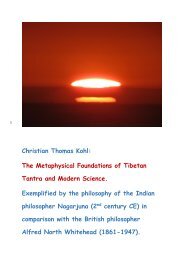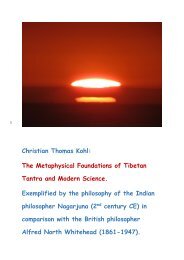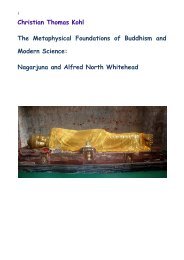Christian Thomas Kohl The Metaphysical Foundations of Buddhism and Modern Science
Christian Thomas Kohl The Metaphysical Foundations of Buddhism and Modern Science
Christian Thomas Kohl The Metaphysical Foundations of Buddhism and Modern Science
Create successful ePaper yourself
Turn your PDF publications into a flip-book with our unique Google optimized e-Paper software.
He told us: Either a situation exists or not. <strong>The</strong>re is not a third possibility.<br />
Now listen to Roger Penrose:<br />
“Quantum entanglement is a very strange type <strong>of</strong> thing. It is somewhere<br />
between objects being separate <strong>and</strong> being in communication with each other”<br />
(Roger Penrose, <strong>The</strong> Large, the Small <strong>and</strong> the Human Mind, Cambridge<br />
University Press. 2000 page 66). This sentence <strong>of</strong> Roger Penrose is a first step<br />
<strong>of</strong> a philosophical generalization in a Whiteheadian sense.<br />
6. Key terms: ‘<strong>The</strong> metaphysical foundations <strong>of</strong> modern science’ had been<br />
examined particularly by three European <strong>and</strong> American philosophers: E. A.<br />
Burtt, A.N. Whitehead <strong>and</strong> Hans-Georg Gadamer, by Gadamer eminently in his<br />
late writings on Heraclitus <strong>and</strong> Parmenides. I try to follow the approaches <strong>of</strong><br />
these philosophers <strong>of</strong> anti-substantialism. By ‘metaphysical foundations’ I do<br />
not underst<strong>and</strong> transcendental ideas but simply the principles that are<br />
underlying sciences.<br />
7. Key terms: ‘Complementarity’, ‘interactions’, ‘entanglements’. Since<br />
1927 quantum physics has three key terms which give an indication to the<br />
fundamental physical reality: Complementarity, interactions <strong>and</strong> entanglement.<br />
<strong>The</strong>se three notions are akin to Nagarjuna’s relational view <strong>of</strong> reality. <strong>The</strong>y are<br />
akin <strong>and</strong> they are very precise, so that <strong>Buddhism</strong> might learn something from<br />
these descriptions <strong>and</strong> quantum physicists might learn from Nagarjuna’s<br />
examples <strong>and</strong> views <strong>of</strong> reality. <strong>The</strong>y might learn to do a first step in a<br />
philosophical generalisation <strong>of</strong> quantum physical experiments. All <strong>of</strong> us we<br />
might learn how objects are entangled or going arm in arm. [<strong>The</strong> end <strong>of</strong> the<br />
summary.]


















